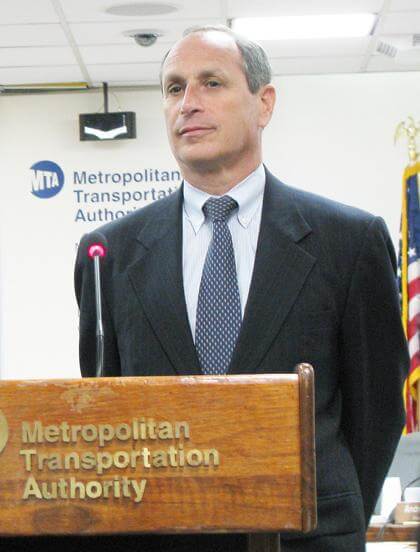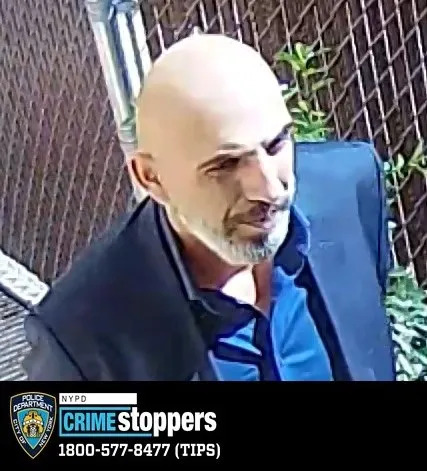By Philip Newman
Elliot “Lee” Sander spoke for an hour in the Great Hall of Cooper Union last year in describing his ambitious vision of the future of the city’s mass transit system.
“As the MTA goes, so goes our region,” he said.
Sander visualized Metro−North Railroad commuter trains vaulting the Hudson River to Rockland and Orange counties and a Second Avenue subway ending up in Jamaica as well as speedier connections to the Rockaway peninsula.
None of this grandiose transit picture will become reality — at least not on Sander’s watch.
The Douglaston resident was forced out of office as executive director of the MTA in what Gov. David Paterson termed a “clean−up and clean−out” of the authority.
In the more than 40 years since the MTA’s inception, Sander is the only career public transportation specialist among the eight previous MTA chairmen.
Sander was executive director of the city Department of Transportation and founder−director of the Rudin Center for Transportation Policy and Management at the Robert F. Wagner Graduate School for Public Service at New York University. He was manager of the Manhattan bus division of the New York City Transit Authority in the 1980s.
“It was my dream job,” Sander said after announcing his resignation.
Transit activists and even some frequent critics of the Metropolitan Transportation Authority give him good marks in his 27 months in office.
“He came up with the idea of appointing separate managers for each subway line as a way of improving accountability,” said Gene Russianoff, attorney for the transit advocacy agency Straphangers Campaign.
He pointed out that “Sander also started the Rider Report Cards, in which straphangers fill out cards on individual subway lines, giving opinions on service in 22 categories.”
Sander also has been credited with improving relations between transit management and the Transport Workers Union in an effort to increase productivity.
In an effort to increase agency transparency, Sander held news conferences following every board meeting.
City Councilman John Liu (D−Flushing), an inveterate critic of the MTA as chairman of the Council Transportation Committee, praised Sander as “a true transportation policy expert.”
“Finances were his second biggest problem; a lack of public confidence being the major problem,” Liu said. “But he did his best.”
Then why is Sander out of a job?
As Liu said, the public’s perception of the MTA seems to be an important factor in Sander’s fall.
The state Legislature had been gunning for the MTA, blaming its leaders for the agency’s abysmal financial straits and accusing them of waste and inefficiency.
State Sen. Majority Leader Malcolm Smith (D−St. Albans) used phrases such as “bloated” and “runaway train” to describe the MTA after the Legislature approved revenue−generating means to bail out the agency.
“We inherited a mess,” Smith said. “One thing I have learned is that people don’t believe anything the MTA says.”
Transit advocates say Sander and the board members inherited the financial problems and should not be held accountable.
Plummeting tax receipts and taxes from a declining real estate market have rapidly worsened the MTA’s financial plight, but the problem began years ago.
That was under the leadership of MTA Chairman Virgil Conway, an appointee and loyalist of former Gov. George Pataki.
It was then that the Pataki administration cut off money for the MTA Capital Program, which pays for new subway and commuter cars, many kinds of maintenance and projects like the Second Avenue subway and the East Side Access to bring Long Island Rail Road trains into Grand Central Terminal.
New York state had contributed $2.4 billion to the Capital Program between 1982 and 1991. From 1992−2004, the state’s contribution totaled $108 million.
Since the state cut off the money, the MTA has been forced to borrow $27 billion for its Capital Program and the bill is coming due. Interest payments will consume $2 billion annually by 2012.
Some transit patrons and elected officials point to what they consider MTA excesses, such as its multibillion−dollar plan, which included heavy cost overruns, to build a new MTA headquarters in lower Manhattan.
Critics also have questioned whether the MTA has always leveled with the public about its finances. In fact, the Straphangers Campaign sued the MTA in 2003, claiming the agency was misleading the public about its finances. Afterward, the MTA gave out more information about finances, making public a preliminary budget long before final approval.
Have transit riders always spoken ill of the MTA?
“Some of the transit−riding public has always been angry with whoever was running the transit system, whether it was in the days subways and buses were privately owned or government−owned,” the Straphangers’ Russianoff said. “What people remember is that it’s the MTA that raises their fare.”
Before each MTA board meeting, members of the public are allowed to speak, with some offering suggestions or complaints, but others simply angry and eager to vent their frustrations.
“Good morning, Mr. Chairman and un−elected billionaires,” one speaker began his tirade recently.
Some straphangers seem to believe the MTA is composed of rich men and women who do not take buses or subways. There are those who believe MTA board members cannot understand there are many riders for whom even a moderate fare increase is a problem, or that thousands need 24−hour service not to go home late after a night on the town, but to go to work.
The present MTA board includes several billionaires. The panel has long had the powerful and influential among its ranks, including many Wall Streeters, attorneys and bankers.
MTA Chairman Dale Hemmerdinger recently acknowledged as “frustrating” an enduring image problem.
Talking about a compulsory audit the state Legislature included in its bailout, Hemmerdinger said: “The fact is that any audit will show all our employees — unionized or not — are overwhelmingly dedicated and hardworking,” Hemmerdinger said.


































